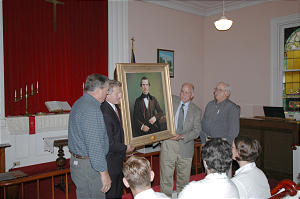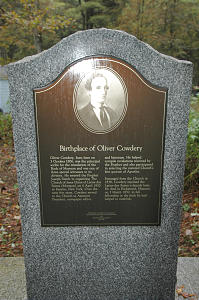Oliver Cowdery
Published September 30, 2006. Reprinted with permission from the LDS Church News a division of the Deseret Morning News.
Oliver Cowdery
200th birthday of scribe, witness of Book of Mormon
R. Scott Lloyd, Deseret Morning News
WELLS, Vt. It was 200 years ago on Oct. 3 that Oliver Cowdery, one of the three special witnesses to the

Photo by Mike Sessions
Book of Mormon, was born in this New England town. Local Church members and townspeople marked the occasion Sept. 23 by gathering in a Methodist church where they heard addresses from a BYU Church history professor and from the president of the Montpelier Vermont Stake.
The celebration was to have occurred on the town green, but a rain shower made it necessary to meet in the Methodist church, where the Rev. David Adams, pastor of the church, and Ron Bremmer, chairman of the town select board (comparable to a mayor) were in attendance.
“In Vermont, Oliver learned the three Rs of reading, ‘riting and ‘rithmatic; when he left, he would learn about another three Rs: restoration, revelation and reconciliation,” said Fred E. Woods, professor of Church history and doctrine, of Brother Cowdery, whose joint statement with his colleagues David Whitmer and Martin Harris appears in the preface of the Book of Mormon affirming the divine vision in which an angel showed them the Book of Mormon plates
Oliver was the “second elder” of the restored Church (see Doctrine and Covenants 20:2) and one of the six founding members of the Church, Brother Woods noted. “Oliver served as Joseph Smith’s scribe in writing the Book of Mormon, which is now considered to be one of the most influential books in America. Thus, today we commemorate an individual who has influenced not only Mormon history and theology, but has also shaped American history and religion.”
Brother Woods traced events of Oliver’s life, including his boarding with the Smith family as a schoolteacher in 1828-29 in Manchester Township, N.Y., and his subsequent meeting with the Prophet; his presence when the Aaronic and Melchizedek priesthood were restored by divine messengers; and his instrumentality in the translation and publication of the Book of Mormon.
Citing Doctrine and Covenants 6, Brother Woods noted that Oliver was counseled to “seek not for riches, but for wisdom” (6:7), that he would be “the means of doing much good” (6:8), and that his inquiring mind led to revelation (6:14-17, 21-24).
“Oliver struggled with the universal sin of pride, as we all do to one degree or another,” Brother Woods said. “He was excommunicated in April 1838 for a variety of issues, which included not supporting the government of the Church. However, G. Homer Durham writes, ‘What may have been false accusations, mingled with misunderstandings growing from the sale of land, finally led to his refusal to appear before a Church council.’ Those who brought the charges all lost their membership and later became enemies of the Church.”
In the subsequent decade, Oliver practiced law, primarily in Tiffin, Ohio, all the while never denying his written testimony of the Book of Mormon, despite, on one occasion, being confronted over the matter in a courtroom by an opposing attorney, Brother Woods recounted.
“During a six-year period (1842-48), Phineas Young, brother of Brigham Young and brother-in-law of Cowdery (Phineas being married to Oliver’s half-sister Lucy) continually wrote and paid visits to Oliver,” Brother Woods said. “At the same time, Church leaders were feeling after Oliver. For example, Willard Richards, who kept the Prophet Joseph Smith’s journal, was directed by Joseph in the spring of 1843 to ‘write to Oliver Cowdery and ask him if he has not eaten husks long enough, if he is not most ready to return.’ The Twelve sent a letter to Oliver with an invitation to return to the fold which, among other things, stated, “Your brethren are ready to receive you…. Your dwelling place you know ought to be Zion.”‘
Oliver responded cordially but was not quite ready to reclaim his Church membership, as he felt the

Photo by Mike Sessions
circumstances surrounding his excommunication had not been examined in their true light, Brother Woods commented.
In October 1848, Phineas Young visited the Cowdery family at their home in Elkhorn, Wis., Brother Woods said. He escorted Oliver, his wife, and their only surviving child of six children to Kanesville, Iowa, to attend the local conference of the Church. There, Oliver addressed the gathering of nearly 2,000 people and requested membership in the Church. In subsequent weeks, he was received back into full fellowship and rebaptized on Nov. 12, 1848.
Desiring to join with the body of the Church in the Salt Lake Valley and launch a fruit-tree business, he first took his wife to visit with her family, the Whitmers, in Richmond, Mo. Failing health would not permit him to undertake the journey west, and he died on March 3, 1850. Brother Woods quoted Oliver’s brother-in-law, David Whitmer, as saying, “Oliver died the happiest man I ever saw. After shaking hands with the family and kissing his wife and daughter, he said, ‘Now I lay down for the last time; I am going to my Saviour’ and he died immediately with a smile on his face.”
President Michael D. Sessions of the Montpelier Vermont Stake said the Church “has deep foundational roots in the Green Mountain State of Vermont. A solid foundation must rest upon a rock, and with the granite of Vermont being covered by only a bit of shallow dirt, there’s plenty of place upon which God could build His latter-day Church.”
The Mormon Historic Sites Foundation is co-sponsoring two other Oliver Cowdery commemorative events. On Oct. 6-7, the Liberty Missouri Stake and descendants of Peter and Mary Whitmer will hold a Cowdery commemoration and Whitmer family reunion in Richmond, Mo. On Nov. 10, an Oliver Cowdery Symposium will be held in the BYU Conference Center in Provo, Utah, from noon to 5 p.m. The event is open to the public and free of charge.
